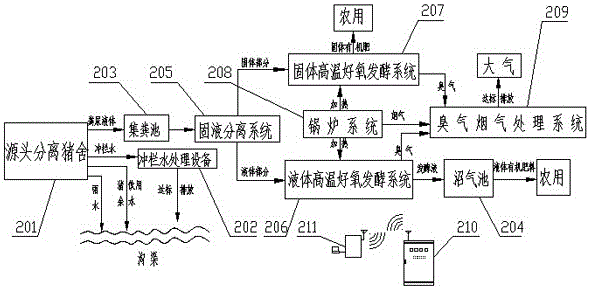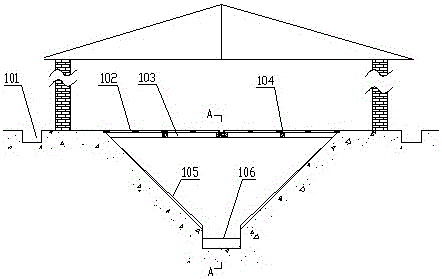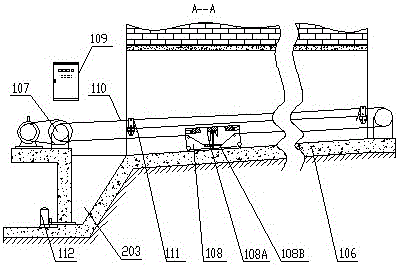In 2009, the
discharge of livestock and
poultry manure in China was 3.264 billion tons of
fresh weight, which was 1.6 times the total industrial solid waste discharge in the same period (Statistics Bureau of the People's Republic of China, 2010).
Feces will decompose into malodorous gases such as
ammonia,
sulfuric acid,
vinyl alcohol,
dimethyl sulfide,
hydrogen sulfide,
methylamine and
trimethylamine in the case of poor ventilation. These gases are harmful to
human health and aggravate
air pollution; second, they pollute water bodies. The arbitrary discharge of livestock and poultry
feces can easily cause
eutrophication of water bodies and deteriorate
water quality. The infiltration of
feces and
sewage into the ground can also cause
nitrate content in
groundwater The third is the spread of zoonotic diseases. There are more than 90 kinds of zoonotic diseases transmitted from animals to humans. The carriers of these zoonotic diseases are mainly livestock and poultry
feces and excreta. Proper disposal and
rational use will not only have a huge negative
impact on the
ecological environment, seriously affect people's health, but also
restrict the healthy development of the livestock and poultry breeding industry
[0003]
At present, the
manure cleaning methods commonly used in large-scale
pig farms at home and abroad mainly include water soaking
manure, water flushing
manure and dry manure cleaning process. At present, the most
common method is water soaking manure cleaning. The
disadvantage is that the manure stays in the pig house for a long time , part of the anaerobic fermentation in the manure
ditch produces a large amount of harmful gases such as
ammonia,
hydrogen sulfide, and
methane, which reduces the
appetite of pigs and endangers the health of pigs. People are forced to use high-energy forced ventilation to solve the problem of
toxic gas pollution. , but in winter, the forced ventilation makes the pig house unable to keep warm, and the pigs are susceptible to infectious diseases such as influenza. At the same time, a large amount of toxic and harmful gases also affect the work of the breeders and endanger the health of the breeders
The dry manure cleaning method, that is, the manure is diverted once it is produced, the dry manure is collected, cleaned, and transported away mechanically or manually, and the
urine and flushing
water flow out from the sewer and are treated separately. There are two kinds of manure cleaning and mechanical manure cleaning. The disadvantages of manual manure cleaning are that people and animals are prone to cross-infection, heavy labor, poor
working environment, and low productivity. The advantages of mechanical manure cleaning are that it can reduce labor intensity, save labor, and improve work efficiency. The production of manure cleaning equipment is still lacking in reliability. The equipment is complex, the incidence of failure is high, and maintenance is difficult. Whether it is manual manure cleaning or mechanical manure cleaning,
urine and flushing water and pig drinking water Mixed, the concentration of pollutants in the flushing water is high, which increases the treatment capacity and difficulty of flushing water
[0004]
Generally speaking, the above-mentioned manure
cleaning methods mainly have the following problems: (1) There is no separate collection and
delivery system for pig drinking water, and pig drinking water is directly mixed with feces,
urine and pen flushing water, which increases the amount of pollution and
treatment costsAt present, the field composting fermentation technology widely used mainly has the following problems: large area, long fermentation time (generally about 15-30 days for one fermentation), fermentation speed decreases or even stops in low temperature weather, and odor is difficult to collect and process, resulting in pollution environment and other issues
At present, most of the research is on trough composting. The efficiency or effect of aerobic composting is improved by means of ventilation and forced
oxygen delivery, turning or stirring. The problems of this method include high investment costs such as infrastructure and turning equipment, and the heat generated by fermentation. and odor are generally allowed to be discharged to the
atmosphere, causing serious secondary pollution; and the famous Dano (Dano) drum type aerobic reactor has the characteristics of high fermentation efficiency and
small footprint compared with field fermentation, but the fermentation The effect depends on factors such as the length of the drum. In order to prolong the
residence time of the fermentation raw materials in the drum reactor to ensure the fermentation effect, the length of the drum is usually designed to be more than 10 or even 20 times the
diameter of the drum, so the floor area is still large. The equipment manufacturing cost is high, and there are also disadvantages such as the contact area between the new fermentation
raw material (organic waste) and the fermented
raw material is too small, and the new fermentation
raw material lacks sufficient fermentation
bacteria, so the
reaction speed is slow.
[0006] At present, the
mortality rate of live pigs in
pig farms is generally 3-5%. Once an epidemic occurs, the proportion will be even greater. Incidents of
drinking water pollution caused by improper handling often occur, and unscrupulous traders resell sick and dead pigs to make huge profits. Threatening the
food safety of ordinary people, the isolation and treatment of these dead animal carcasses carrying harmful germs need to be solved urgently
At present, the methods of harmless treatment of sick and dead pigs mainly include high-temperature
incineration, landfill and high-temperature composting, etc. The high-temperature
incineration method requires extremely high equipment, and the one-time
investment cost is high. Conditions, and centralized
incineration also has a series of problems such as emission pollution, cumbersome collection and transfer procedures, and difficult supervision measures. In addition, the secondary pollution caused by the treatment process is also very serious.
At present, the landfill method is mostly used. The
disadvantage is that the cost of transportation and landfill is high, and the subsidy for sick and dead pigs is much lower than the cost of landfill. Moreover, most farm employees do not perform hygienic landfill due to lack of
hygiene and
safety knowledge, resulting in serious secondary pollution
High-temperature composting is also a kind of harmless treatment of sick and dead pigs. Its
disadvantage is that during the pretreatment process such as smashing sick and dead pigs, mechanical loss,
energy consumption and equipment cleaning will increase the
processing cost. , and the process of replacing vulnerable parts is prone to cross-infection, increasing the risk of
epidemic spread, and composting covers a large area, takes a long time, and is easily affected by climatic conditions. A large number of pathogenic microorganisms are carried in dead pigs, and traditional fermentation methods are difficult. Completely kill these pathogenic microorganisms
Breeding pig farms produce a large amount of
placenta and other
dirt in the process of breeding piglets. Because of its rich
nutrition, it is easy to be corrupted. If it is not treated in time, it is easy to cause pollution. At present, the common way of disposal is landfill, which is the same as the treatment of sick and dead pigs. The problem
[0007]
Pollutants in large-scale pig farms include not only pig feces and urine, flushing water, but also sick and dead pigs,
placenta, and odors and
smoke generated during the treatment process. At present, there is no suitable method to treat the above pollution at the same time thing
Chinese patent CN203568937 discloses a livestock and
poultry manure treatment system, including rain and sewage
separation system, dry-wet
separation system, solid-liquid separation system and ecological purification system. The existing problem is that the manure is mixed with flushing water and drinking water After solid-liquid separation, the liquid after solid-liquid separation contains a large amount of
organic matter and nutrients, and the content of COD and
ammonia nitrogen increases significantly, which not only leads to waste of resources, but also increases the amount and difficulty of subsequent
sewage treatment, increasing the
cost of treatment The separated
solid material is fermented by natural composting method, which occupies a large area of
production area, has low fermentation efficiency,
poor quality organic fertilizer, is easily affected by environmental factors, and is prone to secondary pollution. In addition, the system does not involve livestock and poultry farms Treatment of dead livestock and poultry carcasses and
placenta[0008]
Chinese patent CN201520168695.4 discloses a closed
biodegradation harmless treatment device for sick and dead livestock and poultry. The patent degrades dead livestock and poultry carcasses by adding biodegradable cadaveric agent and other auxiliary materials, and kills parasites and insects through anaerobic fermentation. Eggs, germs and viruses, the disadvantage is that the
decomposition efficiency of dead livestock and poultry carcasses under solid conditions is much lower than that under liquid conditions, anaerobic fermentation cannot completely kill harmful
pathogenic bacteria in dead livestock and poultry carcasses, and there is a risk of secondary pollution
[0009]
Patent CN102964149 discloses a pollution control method for livestock and poultry farms. This method does not deal with dead livestock and poultry carcasses and placentas, and the patent does not involve the use of hot
flue gas and fermentation heat from boiler
combustion, and uses SBR reaction It is difficult to meet the standard when the discharge of flushing water is large in the peak season of slaughtering, etc.
 Login to View More
Login to View More  Login to View More
Login to View More 


